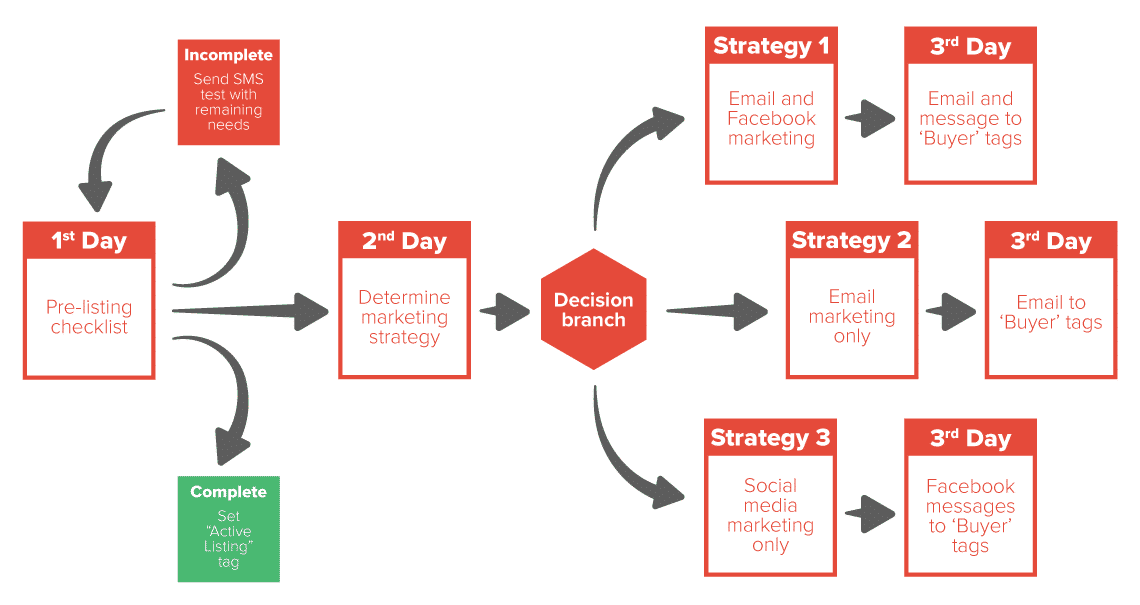Why do ISAs get such a bad rap? Most of us are hired with expectations of “getting the appointment.” Oh, and yes, I say US because as a real estate agent and team leader, I fell in love with the cold calling. I have been making calls for 13 years and built my real estate business on it, doing it myself until I hired and trained ISAs to help scale my business.
The first few inside sales agents (ISAs) I hired were basically just thrown into the fire. There was no manual, no how-to guide, no blueprint for success. I just hired them and said, “Here is the log in. I know there is gold in there, now just start calling and get me some appointments!” What a disaster!
After a year or two, I slowly began to realize that their lack of success wasn’t their fault. I had set my ISAs up for failure.
That’s when I decided to get serious and build systems for my ISAs. And that is what you are going to learn today. My five top tips to train ISAs for success with a system I call the buyer blueprint.
If you would like my ISA scripts, help organize your customer relationship management (CRM) software, and set up basic systems for your own ISAs, you can download it all here.
1. The Devil Is in the Details
The goal is working smarter, not harder, right? Paying specific attention to details when a lead first registers can not only save time, but it customizes the experience for the lead and increases the chances for conversion. Here are two great examples of small details that can have a huge impact on your ISAs’ success:
Verify Bad Phone Numbers
In my 13 years of experience calling leads, I’ve found that no matter what CRM platform your ISAs are using or what kind of leads you are generating, 30% of phone numbers are going to be either wrong numbers or disconnected.
So make sure to have your ISA confirm phone numbers on the first call attempt. This eliminates wasting time in the future calling numbers that are not good.
Look for Typos in Email Addresses
Train your ISA to scan the email address and look for any possible typos while the phone is ringing and they’re waiting for the lead to pick up. An example of this would be .con instead of .com, maybe a name typo, or @gnail instead of @gmail. I have even seen typos in their name within the email, such as Sara but the email is Sata. The R and T are right beside each other on the keyboard—easy mistake. Fix it.
Most CRMs mark it as a bad email when the first email bounces, but why not try to fix those mistakes before you start getting returned emails in your drip campaign?
Confirm Their Voicemail
Allow the first call attempt to go entirely to the voicemail to listen if the correct name is on it. Make a note and update the lead profile if they only gave a first name when they first registered. This is an important step for emails going to the lead with the autofill feature. How do you feel when you get an email with your name spelled wrong?
The devil is in the details!
Make Sure to Mark Leads as Night Calls When They Request It
If the lead requests to have them call back when they get home from work, make sure to have your ISA mark the lead as a night call in your CRM and have a separate filter to call on evenings and weekends. There’s nothing worse than calling a lead at a time that doesn’t work for them when they specifically request you don’t.
2. Build Automated Call Filters for Leads You Have Not Reached Yet

I always said if I could make calling leads like playing Candy Crush, we could get ISAs addicted to making calls. So I built call filters to crush the dials! Building call filters in your CRM of choice can help gamify cold calling for your ISAs and keep them engaged.
As an ISA or anyone calling leads, the main objective is to have conversations. Yes, we want appointments, but you can’t get appointments without the conversations. Building call filters saves a ton of time not having to think about who to call when.
If you’re not sure where to start, here are four main call lists (filters) that should be your priority.
New Leads
These are the leads that have recently registered that have no attempted calls yet. Create a filter just for these leads. It is easiest if you can put them into a “new” status; that way, they are designated as new and easily recognized.
Leads Registered in the Last 14 Days That You Have Not Reached Yet
Be clear on keeping leads you have never spoken to in an “attempting contact” status to separate them from the new leads and those leads you have already spoken to—the filter should consist of:
- Leads who have registered in the last 14 days
- Status of attempting contact
- Valid or unknown phone numbers
Set your CRM up so that leads automatically fall out of this filter after the 14th day of registering or when the ISA moves the lead status to “contacted.” As the new leads are coming in, your filter is always moving out with the old and in with the new. The more conversations you are having, the smaller this list becomes. You should set and reward goals of a minimum of six to eight call attempts within the first 14 days for your ISAs.
Talk about motivation to have conversations!
Active Leads
This is one of my favorite filters because older leads you have not spoken to who decide to start looking at homes again automatically fall in this filter. If they have been dormant from looking and all of the sudden start again, don’t you want to know?
This filter should consist of:
- Leads registered 15 or more days ago
- Leads active within the last 30 days
- Leads needs to be in a status of attempting contact
- Valid or unknown phone number
They will fall out of this filter if you move the status to anything other than the status it was in OR if they have NOT been active within the last 30 days. These leads should be called every seven days. Yes, at different times each attempt.
Just note that you’ll need an IDX website with an integrated CRM like Propertybase in order to know when your old lead becomes active again on your website.
Inactive Leads
These are the leads that have NOT been actively looking at homes or logged in for 31 or more days. These leads are moving further down the priority call list because by now, they should have had a minimum of six to eight phone calls at different times.
If they haven’t answered the phone in that many attempts, they need to drop way down in your ISAs priority call filter. This list should consist of:
- Lead active 31 days to 5,000 days
- Lead needs to be in a status of attempting contact
- Valid or unknown phone number
As you might already know, this is going to be the majority of your database. Remember these are ALL leads you have NEVER spoken to. They do not need any reminders or extra attention.
You could technically break this large list of leads out into months of inactivity if it is too large. For example, inactive 31 to 120 days, inactive 121 to 180 days, and so on.
These leads should be called monthly, and the longer they go inactive, the less often they need a call. This is where mass texting or emailing is great to get them to raise their hand without taking up too much of your ISA’s time with too many phone calls.
3. Organize Conversations & Build the Pipeline

This is where the rubber meets the road if you want to know why your ISA’s conversion level is not where you want it to be. LISTEN UP
All conversion is lost after the first conversation.
SAY WHAT? Yes, it is true. Stop overtasking! I know you are overwhelmed with overdue tasks. Agents and ISAs task everything because they don’t want to forget anything. Then everyone is forgotten because the task list becomes endless and there are only so many hours in a day.
Follow these steps and I promise you will convert more leads without overtasking your ISAs.
Your ISA should be asking detailed questions to determine what needs to happen for the lead to make a move or not, knowing their motivation and timeline, and finding out when they are in need of an agent.
I like to rate these conversations based on their chances of sitting at the settlement table in the near future. Is there a 70% chance this lead will be sitting at that table in the next few months? If so, then you better believe that you should assign tasks to your ISA for these leads.
Here are three basic steps to follow with three main kinds of leads you’ll have in your CRM:
- The agent has a 70% chance or higher of sitting at the closing table with that lead IF there is proper follow-up. THIS IS THE AGENT’S PIPELINE—treat it like future business. These get a reminder/task/follow-up with a specific date.
- Based on the conversation and information received, the lead is not a high-quality lead, but you don’t want to forget them. They are in the research phase; they want to be updated on prices and what’s going on with the market. These leads can get a tag/label to monitor their activity on your website or drip campaign. Confirm their email address, set their home search criteria, and check in with them every now and then. This process streamlines follow-up because you can view the entire group of leads from the dashboard and call those that are not active.
- These leads are so far down on the priority list that you really don’t have high-priority needs to check in. Those who really have no plans, just curious because maybe someday. Those who are a few years out because of retirement, kids school, bad credit—the list goes on. Label them with their situation. Examples: Already Purchased, Retiring, On Hold, Has an Agent.
4. Make Nurturing Your Leads Easy by Asking the Right Questions

After years of coaching ISAs and agents, I have heard variations of this next question nearly every day:
What do I say when I follow up?
This is actually a surprisingly complicated question, but I am going to keep this simple. Stop overthinking what to say and focus on having your ISAs ask questions instead. Remember, she who asks the questions controls the conversation!
Asking the right questions helps keep the ISA on track with getting the right information, and also lets the lead feel more confident in the conversation because you are asking them questions and letting them talk. Who doesn’t love to talk about themselves?
If you’re looking for specific questions to ask, get a copy of my questions here.
Example Question-based ISA Script
Scripts in my opinion are good for reference, but not a one-size-fits-all solution. That’s because they sound too … well, scripted. The lead can tell. Believe me when I say that. Just have a conversation like you are talking to your best friend about them buying or selling a home. That means actively listening and responding with insightful questions that help set expectations.
Here is an example of active listening and responding with insightful questions:
Lead: I am not going to be able to do anything until my company makes a decision on their move. We are at least six months away from anything happening.
Agent: Totally understand. In the meantime, what could I do for you that may be helpful for you?
Lead: I would really like to get an understanding of what prices are where and what homes are going for.
Agent: Great. Let me set you up to receive listings (get their criteria). This is a general search just to give you an overall idea. How often would you like me to check in?
Lead: Oh, I don’t know.
Agent: I’ll tell you what, how about I just check back in a couple of weeks, make sure you are getting the listings and just see if you have any questions or need me to make any changes. We can just take this month by month until you know what is going on.
And always feel free to add: We are here as a resource for you and look forward to the opportunity of earning your business.
Ask, then set the expectation. It’s as simple as that! Sadly, this is where so many ISAs and agents fail so often in their nurturing. But if you can have them master the follow-up, and master active listening and asking great questions, your ISA will convert more leads than you ever thought possible.
5. Get Your Own Buyer Blueprint in Writing: Create a Detailed ISA Training & Best Practices Manual

Do you want to attract talent? Do you want to get high-level results? Then you need to always remember that the system is only as good as the person who designed it. It is great to have effective systems in place, but that system needs to be built from experience and managed. The more organized you are, the more organized your ISAs will be—and the more they will convert. It’s as simple as that!
Having proper guidelines spelled out in a training manual will ensure everyone on the team will be working the system the same way. This way, it’s much easier to figure out if you have people problems or system problems. With any change to the system, you should see results from every single ISA on your team. If not, you likely have a people problem and not a systems problem.
Is Your Business Ready for a Mack Truck?
One thing I always tell my coaching clients is to treat their business as if they would be hit by a Mack truck tomorrow. Could your business or company run if something happened to you tomorrow? If the answer is no, you better get busy with systems and best practices. A comprehensive training manual should mean your business can run smoothly with or without you there.
A Comprehensive Training Manual Makes Accountability Easier
Before I had my systems and training manual in place, when I hired an ISA who disappointed me, it would weigh on me heavily. My first thought was to just fire them. But I always had to pause before firing them because I knew it was mostly my fault for not setting expectations or explaining my values. Of course they weren’t accountable—because I never set concrete expectations for them!
When I finally had systems in place and in writing, they would actually know exactly why and how they weren’t meeting expectations and knew exactly what they needed to improve. That awful confusion and guilt of having to fire an ISA for what were essentially my own shortcomings as a manager was eliminated. They already knew my best practices and exactly what to do every day to succeed.
The amazing thing is that best practices are nothing more than a written manual of how-tos. We love to overcomplicate this process by overthinking everything, but what could be simpler than making a record of everything you do? Write down your steps of the process, make it a video tutorial, give it to your ISA and voilà, you have a manual of best practices that will keep your ISAs accountable and on the path to success. So why do so many team leaders not do it?!
Over to You
Have a great tip for training ISAs? Having trouble getting your own ISAs to convert? Let me know in the comments or call me for a private coaching session.



Add comment